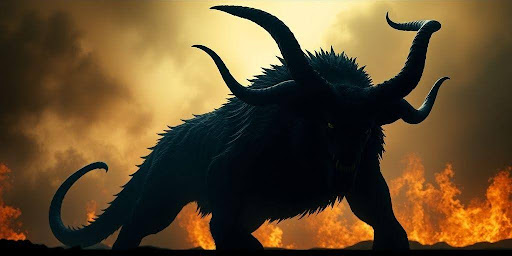What the Bible Really Says About the Beast in Revelation

For centuries, people have pondered the identity of the figure known as the beast in the Book of Revelation. Is this entity a literal being, or does it represent something more symbolic? The Bible offers insights into this complex figure, and understanding its context is key to grasping its message.
Revelation 13 presents a vivid, almost nightmarish vision of a beast emerging from the sea. This creature is described with striking features, drawing comparisons to a leopard, bear, and lion, and possessing ten horns and seven heads, each adorned with a crown and a blasphemous name. This imagery is not arbitrary; it carries significant symbolic weight, drawing parallels with earlier prophetic visions found in the Book of Daniel. These earlier visions also depicted beasts representing powerful kingdoms or empires.
The beast of Revelation is depicted as receiving its power and authority directly from the dragon, which is understood to represent Satan. This connection highlights the ultimate source of the beast’s influence and its adversarial role against divine will. The beast is granted dominion over all nations, commanding worship and wielding immense power for a specific, limited period. The Bible’s description of the beast is meant to be understood through its own prophetic language, where animals and composite creatures often symbolize political powers and their characteristics.
The Beast’s Description and Origins

Who is the Beast of Revelation?
The Book of Revelation introduces us to a significant figure, often referred to as “the beast.” This entity, described in vivid detail, emerges from the sea. Its appearance is a composite of powerful animals, drawing from imagery found in earlier prophetic books like Daniel. This beast isn’t just a random creature; it’s a symbol of immense power and a formidable opponent to divine authority.
Many have spent centuries trying to pinpoint its exact identity, debating whether it represents a specific historical figure, a political system, or a more abstract concept of evil.Those exploring the question “who is the beast of Revelation” will find compelling insights at Prophecy Course, which connects biblical symbolism with historical and theological interpretations.
The Beast’s Symbolic Representation
The beast is depicted with characteristics that blend the leopard, the bear, and the lion, mirroring the visions of kingdoms in Daniel’s prophecy. This amalgamation suggests a power that consolidates or draws from previous empires. It’s given authority by the dragon, identified as Satan, highlighting its role as an instrument of evil. The beast speaks blasphemies against God and exercises dominion for a specific period, 42 months, a detail that has been subject to much interpretation. Its very nature is a representation of worldly power that opposes God.
Historical Context of the Beast
When John wrote the Book of Revelation, the Roman Empire was a dominant force, often persecuting early Christians. Many scholars believe the beast’s description was intended to resonate with the Christians of that era, possibly alluding to the Roman Empire or specific emperors who demanded divine honors. The beast’s rise from the sea, a symbol of chaotic nations, and its composite nature could have been understood as representing the oppressive and multifaceted power of Rome. Understanding this historical backdrop helps in grasping the initial message conveyed by the beast.
The Beast’s Power and Authority
Global Dominion of the Beast
The Beast of Revelation is depicted as wielding immense global authority. It’s granted power over every tribe, people, language, and nation. This widespread dominion means that all inhabitants of the earth, except for those whose names are in the Book of Life, will eventually worship it. This isn’t just political control; it’s a totalizing power that commands military force and demands absolute obedience.
The Beast’s Blasphemous Nature
This entity is characterized by its blasphemous speech, directing its arrogant words against God himself. Its seven heads bear names that are blasphemous, suggesting claims to divinity. This mirrors the dragon’s influence, as the beast receives its authority and power from the dragon, essentially acting as its earthly representative. The beast’s blasphemous nature highlights its opposition to the divine.
Authority Granted to the Beast
The authority the Beast exercises is not its own; it is given to it. This divine permission allows the Beast to wage war against God’s people and conquer them for a specific period. While this might seem like a victory for evil, it’s within God’s sovereign plan. The Beast’s authority, though vast, is temporary and ultimately serves God’s purposes, even in judgment. This granted authority is a key aspect of understanding its role.
The Beast’s Fatal Wound and Recovery
The Beast’s Mortal Injury
Revelation paints a dramatic picture. One of the beast’s heads takes a blow, seemingly fatal. It’s described as a sword wound, one that appears to end the beast’s existence. This event is quite a shock to observers.
This injury is a significant moment. It suggests a period of collapse or defeat for the power the beast represents. The text emphasizes the severity of this wound, making its subsequent recovery all the more astonishing to those watching.
It’s a moment that shakes the world’s perception. The beast, thought to be finished, is about to make a comeback. This turn of events is central to understanding the beast’s influence.
Miraculous Healing of the Beast
But then, something incredible happens. That mortal wound? It heals. The beast, against all odds, recovers. This isn’t just a minor comeback; it’s presented as a miraculous revival.
This healing is a key part of the narrative. It’s what causes widespread amazement. People can’t believe what they’re seeing. The beast that was struck down is now alive and seemingly stronger.
This recovery is meant to be impressive, even deceptive. It draws people in, making them wonder about the source of such power. The beast’s recovery is a major spectacle.
Global Astonishment at the Recovery
The world reacts with awe. Seeing the beast, which had suffered a fatal wound, come back to life is astounding. This recovery leads many to follow and worship the beast.
This widespread amazement is significant. It highlights the deceptive power at play. The healed beast captures the attention and admiration of the earth’s inhabitants.
The recovery of the beast is a powerful illusion, designed to mislead. It’s a display that makes people question reality and turn towards this seemingly resurrected power.
This event causes the whole earth to marvel. They follow the beast, captivated by its apparent triumph over death. It’s a moment of global wonder, but also of great deception.
The Beast’s Role as an Enemy
The Beast’s War Against The Saints
The beast from the sea is depicted as a formidable adversary, specifically targeting God’s faithful followers. The text states that this entity “was given power to make war against the saints and to conquer them.” This indicates a direct conflict, where the beast, empowered by darker forces, actively seeks to overcome and subdue those devoted to God. It’s a struggle for spiritual dominance.
This conflict isn’t just about physical harm; it’s a spiritual battle. The beast’s actions are designed to test the faith of believers. Christ’s followers will face intense pressure, being hated and persecuted by nations because of their allegiance to Him. This period will challenge their resolve, forcing them to choose between worldly power and divine loyalty.
Persecution of God’s People
The beast’s agenda involves the systematic persecution of God’s people. It’s not a random act of violence but a calculated effort to eliminate or suppress those who refuse to align with its agenda. This persecution is a defining characteristic of the beast’s opposition to the divine.
The intensity of this persecution is significant. Believers will be handed over, persecuted, and put to death. This highlights the extreme measures the beast will employ to assert its authority and silence dissent. The goal is to break the spirit of God’s people.
The Beast’s Limited Time of Rule
Despite its power and the severity of its persecution, the beast’s reign is not eternal. The narrative emphasizes that its authority is limited to a specific period. This limited timeframe offers a glimmer of hope amidst the struggle.
This period is often described symbolically, such as 42 months or three and a half years. It’s important to understand these numbers as having symbolic weight rather than strict literal interpretation. This limited duration underscores that the beast’s power is ultimately temporary and under divine control.
The beast’s ultimate defeat is assured, even as it wages war against the saints. God’s sovereignty remains, and this period of intense trial is part of a larger divine plan.
Identifying The Beast’s Number
The Mark of the Beast
The Book of Revelation speaks of a mark required for buying and selling. This mark is directly linked to the beast, either its name or the number of its name. It’s a sign of allegiance to the beast’s system. Without this mark, individuals are excluded from economic activity. This concept has sparked much debate and interpretation throughout history.
The mark serves as a visible identifier of those who follow the beast. It’s not just a random symbol but a declaration of loyalty. The implications of receiving this mark are profound, signifying a rejection of divine authority in favor of the beast’s power.
The Number of the Beast
The number 666 is famously associated with the beast. Most ancient manuscripts and translations point to this specific number. However, some older sources, like Papyrus 115, suggest the number might have been 616. This variation has led to different theories about its meaning.
This number is described as “the number of a man.” This suggests a human origin or connection to a specific individual. The exact calculation and meaning of the number of the beast remain a subject of intense study and speculation among scholars and theologians.
Calculating the Beast’s Name
Calculating the beast’s name often involves using ancient methods of gematria, where letters are assigned numerical values. Many believe that by applying these systems to names from the first century, one can arrive at 666. This approach seeks to uncover a hidden identity behind the symbolic language.
However, the lack of a universally agreed-upon method means many different names can be derived. Some scholars suggest the number isn’t meant to be a direct code but rather a symbol of imperfection. Six, being one short of the perfect number seven, could represent humanity’s fallen state or the beast’s attempt to mimic divine perfection. The number of the beast is a complex symbol with layers of meaning.
| Manuscript/Source | Number Attributed | Notes |
| Most NT Manuscripts | 666 | Standard reading |
| Papyrus 115, Codex Ephraemi | 616 | Older textual evidence suggests this number |
Interpreting the number of the beast requires careful consideration of historical context and the symbolic language used in Revelation. The focus is often on understanding the nature of the beast and its opposition to God, rather than just a numerical puzzle.
Wrapping Up Our Look at the Beast
So, when we look at the Bible’s descriptions of the beast in Revelation, it seems to point to a powerful, oppressive system, likely a government or empire, that opposes God and His people. It’s described as having a deadly wound that heals, which has led many to think about historical figures or events. The text also mentions a second beast, often seen as a religious or persuasive force that supports the first.
While the exact identity has been debated for centuries, the core message is about a force that demands ultimate loyalty, something the Bible says belongs only to God. It’s a warning about the dangers of idolatry and the importance of staying true to one’s faith, even when facing intense pressure or persecution.



